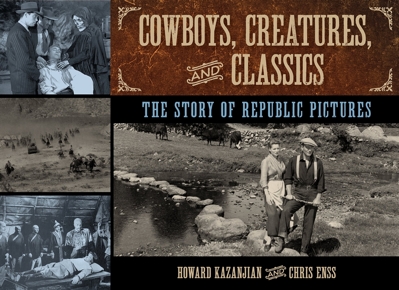
Not so many generations ago boys and girls of all ages flocked to movie houses across the country to watch gallant heroes in white hats outwit sinister bankers or corrupt government officials. They shrieked as lovely damsels in distress dangled precariously on a branch high above a yawning chasm. They cheered when the good guy rescued the frightened female and applauded when the villain in the black hat was hauled off to the hoosegow. Only a handful of Hollywood movie companies in the post-depression era produced such films and among those only one dominated the business – Republic Pictures.
Some of Hollywood’s most notable stars and best known characters of the 30s, 40s, and 50s rose to prominence at Republic Pictures. For nearly twenty-five years the studio produced Saturday afternoon serials starring such characters as Rocket Man, Dick Tracy, The Lone Ranger, Zorro, Captain Marvel and countless “cowboy operas” or singing cowboy pictures starring such well known figures as Roy Rogers and Gene Autry. The studio helped launch the career of the legendary John Wayne, who made thirty-three films for the company, including such notable efforts as Sands of Iwo Jima, The Quiet Man, and the Fighting Seabees.
Under Republic Picture’s majestic banner of an eagle perched high atop a mountain peak, low budget, action films such as Spy Smasher and the Perils of Nyoka were made. Big budget motion pictures such as Macbeth and Man of Conquest were also produced by the company recognized as one of history’s most prolific studios. More than 1,100 movies were made by Republic Pictures during the twenty-four years the studio was in existence.
Republic was the brainchild of Herbert J. Yates, who founded the studio in 1935 when he convinced several smaller studios such as Chesterfield, Monogram and Mascot to consolidate under one banner. The company wasted no time in establishing itself as one of the most productive and efficient in Hollywood.
Yates assembled a talented group of directors, technicians and performers who merged into a hardworking, dedicated team. Republic’s special effects duo of Howard and Theodore Lydecker was hailed as the best in the business. Its music department was equally effective. Such notables as future Broadway producer Cy Feuerand and eventual Academy Award winner Victor Young scored films for the studio.
And at Republic, stunt work became an art. Yakima Canutt, David Sharpe, and Tom Steele were among the stuntmen who worked there, and all three became legends within the movie world.
Republic’s filming techniques were just as fast-paced as its final products. Whereas major studios might shoot only three or four scenes in a day, Republic would shoot dozens. The directors of the high energy, thrill-a-minute chapter plays were driven, talented men such as Joseph Kane, John English, and William Whitney. Kane, English, and Whitney directed the majority of the westerns and cliffhanger serials produced by the studio. Between 1939 and 1942, Republic turned out sixty-six multipart, cliffhanger serials.
Yates depended on the speed and flexibility of his stable of actors, writers, directors, and behind the scenes talent to bring to life the topical projects he believed audiences wanted to see. For example, within a week after the Japanese bombed Pearl Harbor, Republic writers were at work on a script built around the incident. In less than six months, “Remember Pearl Harbor” was playing in the nation’s theatres.
Yates not only built plots around current events, but on popular songs too. When the tune “Pistol Packin Mama” became a hit, Yates quickly put out a film with the title.
Republic produced a number of low budget or “B” horror and mystery films, but it was the cowboy westerns and serials that remained the company’s bread-and-butter throughout its history. Those B pictures usually ended with the bad guy being arrested or killed and were extremely popular with movie goers.
When television exploded on the scene in the 1950s, it signaled the beginning of the end of Republic Pictures. People no longer needed to go to the theatre to see their heroes save the day. The little pictures for which the studio was noted became less and less profitable due to rising costs and the allure of T.V. The studio closed in 1959.
Killer Bs: The Rise and Fall of Republic Pictures tells the story of the ambitious film company that made a big impact on Hollywood and influenced some of today’s most gifted filmmakers and industry leaders. It’s a tribute to cheap thrills and guilty pleasures.
Included in the book is information about the actors who helped to make Republic Pictures popular and one in particular many believe responsible for the studio’s decline. The careers of the special effects artists, stuntmen, and the films that brought them fame and fortune are examined in the book too.
So, grab a bag of popcorn and a bottle of soda pop and relive the excitement and thrills of those wonderful, bygone days before television when Republic Studios was king and B pictures ruled the box office.

